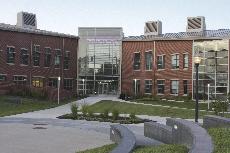 Brian Tedder/Collegian
Brian Tedder/Collegian Brian Tedder/Collegian
Brian Tedder/CollegianStarting this fall, the new $26 million Studio Arts Building at the intersection of Infirmary Way and North Pleasant Street will reveal more than its multicolored lights to students and faculty. Funded by the UMass Building Authority, the 47,394-square-foot-building will bring the Studio Arts Program under one roof. Previously students and faculty were scattered across campus in different outdated facilities in the Fine Arts Center, Art Barn and Munson Annex. On the first day of classes, students will be in an environment with new art supplies, studios and classrooms. Students will use new equipment, including saws and drills for woodworking, metal-cutting machines, a transport system for heavy metal sculptures and pottery wheels and a kiln for ceramics. The art studios are either private or communal and designated by seniority. “I am really looking forward to having my own space in this social environment. It will enhance my experience in the art department this year,” said senior art major Irene Ushomirksy, who will be working with oil and water based painting this year. The communal studios will give students the opportunity to interact with others in diverse artistic backgrounds. “It’s awesome when undergraduates and graduates come together because it lets everyone kind of get real,” said senior art major Kyle Nilan. This semester, Nilan will work toward his thesis by experimenting with different media and printmaking. Another space for social interaction is the Student Commons, located under the glass cube on the upper level. The museum-style hanging walls in the commons will be used to display artwork. Art Department Chair Bill Oedel said the building brings the art department together as one community. Faculty will lead its classes in instructional studios for painting, sculpture, ceramics, printmaking and photography. Each classroom has a digital overhead with an automatic screen for projection. On the first floor, the instructional painting studio has a pedestal in the center of the room for a model to pose upon. Above the pedestal, there is a radiating heat panel for the model’s comfort. In the half basement level, there are instructional studios for digital and print photography. The darkroom has new enlargers and a film drier that dries wet film in just 10 minutes. Also, a stainless steel sink with a ventilation panel rids the room of the toxic fumes from the chemicals used for printing. Safety measures like ventilation panels, emergency showers and storage compartments for flammable and toxic materials are present throughout the building. And it’s no accident. “Safety is a huge concern in the art world and a prime driver in the design of the building,” said Capital Project Manager Burt Ewart, of Facilities and Campus Planning. Art students are required to participate in safety training before they are allowed to work in the studios. During the one-hour tutorial, students must sign an agreement to abide by safety rules issued by UMass Environmental Health and Safety. Oedel said the new building is critical in sustaining the art department because of the safety issues posed by the old facilities. According to Ronald Michaud, art professor and former department chair, the areas most affected by outdated materials were photography, three-dimensional studies, ceramics and digital arts. In the building’s design, principal designer Laura Cabo incorporated “green” concepts like occupancy sensors that automatically turn off lights when rooms are unoccupied and alarms that will report unnecessary levels of energy use. Cabo is an associate of Gund Partnership in Cambridge. The entrance of the building has pivoting walls that slide together to give a view of the terrace or can lock into place to make an art critique room. “It’s important to have open wall space,” said Oedel. Most of the walls in the building are made of Sheetrock, where art pieces can be easily tacked. However, behind the Sheetrock there is a layer of thick plywood that can be drilled for hanging heavier artwork. The Studio Arts Building will be dedicated on Sept. 19. To celebrate the opening, a glass sculpture by artist Shan Shan Sheng, who received her MFA through the art department in 1987, will be displayed in the Student Commons. “The quality of the environment and community has been improved and the art produced will be enhanced,” said Oedel. Sara Afzal can be reached at [email protected].






